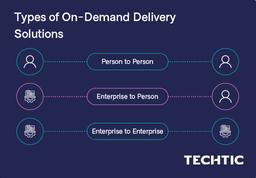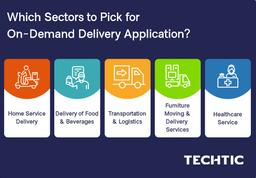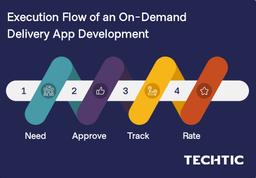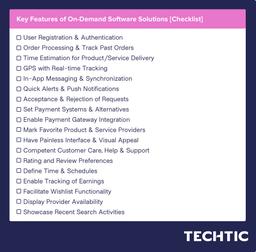Quick Guide to develop an On-Demand Delivery App
Sector: Digital Product
Author: Hemant Kumar
Date Published: 12/31/2020

Contents
- Types of On-Demand Delivery Solutions
- Which Sectors to Pick for On-Demand Delivery Application?
- Execution Flow of an On-Demand Delivery App Development
- Key Features of On-Demand Software Solutions
- Quick Steps to Follow to Build an On-Demand Delivery App
- Cost to Build an On-Demand Delivery Application
- Wrapping Up
On-demand delivery apps are transforming and revolutionizing one industry after another. With success enabled by Uber or Ola as a taxi-hailing application is now everywhere from grocery to logistics and healthcare.
Taking the example of the On-Demand Food Delivery App, the online food delivery niche generated over $136,431 million in 2020. Total market revenue expects to grow by 7.5 percent, resulting in a projected market volume of US$182,327m by 2024. It is forecasted to be serving 965.8 million users by 2024.
Types of On-Demand Delivery Solutions

1. Person to Person (P2P)
Here, a person demands a service or product from the other, utilizing the same platform provided in the structure of an app facilitated by the enterprise. Examples include Uber, Postmate, and Airbnb.
2. Enterprise to Person (E2P)
Enterprises build their on-demand application to offer their services and supply their products. Domino’s delivers its food items to anybody who downloads their app and orders.
3. Enterprise to Enterprise (E2E)
An enterprise depends on other smaller enterprises to operate its business functions seamlessly. For instance, Walmart’s suppliers utilize mobile applications connected to Walmart’s supply chain solution platform to enable operational services.
Which Sectors to Pick for On-Demand Delivery Application?

1. Home Service Delivery
From fixing leakage problems to fixing electronic devices, you can download the mobile app and hire professionals who will quickly show up at your home to resolve the required challenges.
2. Delivery of Food & Beverages
On-Demand Apps facilitate us to have our meals at our doorsteps with merely a few clicks and quick time. Examples include Swiggy or Zomato.
3. Transportation & Logistics
Even though Uber and Lyft are worldwide leaders, several new apps offer similar services in diverse countries, with immense prospective still present in this domain.
4. Furniture Moving & Delivery Services
The shifting business can even utilize on-demand delivery apps. Examples include applications such as Dolly and Lugg.
5. Healthcare Service
Users can monitor in real-time their ordered medicines and delivery at home or healthcare professional’s commute time.
Execution Flow of an On-Demand Delivery App Development

1. Need
A person needs a service or product and waits for the provider’s action. Despite diverse app categories, the seeking methodology stays similar.
2. Approve
The provider can readily approve or disapprove the service request for on-demand applications in the ‘Person to Enterprise to Person’ use case. On the other hand, in E2E applications, the contract amid both business parties decides. However, in E2P apps, disapproval is hardly ever a case.
3. Track
The user can explore the progress of the product orders or service enablement. When the service provider is in the route, the user can monitor and track its overall movements on a map within the mobile app.
4. Rate
The person rates the service through stars, writes feedback, or reviews the service or product they received through the provider.
Key Features of On-Demand Software Solutions

- User Registration & Authentication
- Resourceful User Management
- Order Processing & Track Past Orders
- Time Estimation for Product/Service Delivery
- GPS with Real-time Tracking
- In-App Messaging & Synchronization
- Quick Alerts & Push Notifications
- Acceptance & Rejection of Requests
- Module to Start & End the Service
- The Matching of Diverse Algorithms
- Set Payment Systems & Alternatives
- Enable Payment Gateway Integration
- Mark Favorite Product & Service Providers
- Have Painless Interface & Visual Appeal
- Competent Customer Care, Help & Support
- Rating and Review Preferences
- Define Time & Schedules
- Enable Tracking of Earnings
- Facilitate Wishlist Functionality
- Display Provider Availability
- Showcase Recent Search Activities
Quick Steps to Follow to Build an On-Demand Delivery App
![Steps to Follow to Build an On-Demand Delivery App [Checklist]](/_gatsby/image/2d892d1a010894d6b21908ddb95d76a3/a877c4582a0a0aeb75cc0dea2d2a595d/Steps-to-Follow-to-Build-On-Demand-Delivery-App.jpg?u=https%3A%2F%2Fbackend.techtic.com%2Fwp-content%2Fuploads%2F2020%2F12%2FSteps-to-Follow-to-Build-On-Demand-Delivery-App.jpg&a=w%3D256%26h%3D278%26fm%3Djpg%26q%3D75&cd=8cfc4bf8027ea8c5997323bbe3f2bb89)
- Identify the precise target audience and verify their needs
- Find out challenges common to them
- Analyze competition by app stores
- Determine on-demand participants
- Create a feature-set for every participant
- Prepare a checklist for functionalities identification
- Check functionalities will offer satisfaction to users
- Post your idea and concepts on engaging communities
- Reach investors, merchants and execute budget planning
- Work on final cost estimations
- Work on Minimum Viable Product (MVP)
- Enable the user acceptance test
- Select the layout of your application
- Pick a separate app version for end-users
- Select a precise delivery management software
- Get analytics monitoring and tracking for the app
- Define peak hours, in-app paid, and advertising functions
- Facilitate pricing, delivery charges, discounts, and commissions
- Enable payment system, monetize, test, and launch the app
- Publish on the relevant app stores
- Manage status, challenges, insights, and reports
Cost to Build an On-Demand Delivery Application
The overall cost depends on a mixture of factors. But our strategy and on-demand delivery application development teams have calculated average pricing by research and previous experiences.
It would cost around $7,000 to $9,000 with committed professionals building your on-demand app with a time frame of approximately 8,00 to 9,00 hours.
Wrapping Up
Is it the right time to launch and introduce an on-demand delivery startup in 2021? Our response is yes, as the delivery markets prolong to grow, and there are still numerous cities without on-demand delivery services. As an On-Demand Delivery App Development Company, we can help you make on-demand delivery applications for your business.
Latest Tech Insights!
Join our newsletter for the latest updates, tips, and trends.







